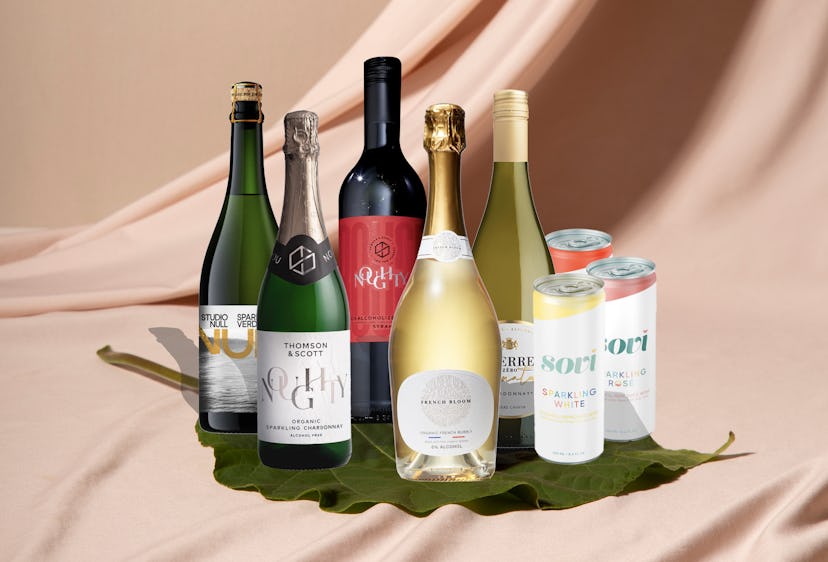I'll Drink To That
Here's The Best Nonalcoholic Wine For Every Occasion
From the best picnic wine to the best bottle for your Bachelor watch party.

In recent years, nonalcoholic wine has enjoyed a surge in availability and popularity thanks to technological advances and an increased interest in alternatives to alcohol.
Nonalcoholic wine starts as regular wine that is put through a vacuum, which lowers its boil point to room temperature to allow the alcohol to boil off, according to Nick Bodkins, co-founder and CEO of Boisson, a nonalcoholic beverage retailer in New York, California, and online. If you don’t drink alcohol, be sure to check the label: some wine labeled nonalcoholic still contains up to 0.5% alcohol by volume (ABV).
Either way, don’t expect the end result to taste like regular wine: the dealcoholization process removes a lot of the flavor. “What is gone, most often, on the white and rosé side is kind of the [aroma],” Bodkins says. “It causes the wine to be a little more acidic than it was, and that has to be balanced out. In reds, that tannic expression, that piece about a red that punches you in the face, that typically goes as well.”
To compensate, producers will add grape juice, sugar, and other boosters. When choosing a nonalcoholic wine, Bodkins advises not trying to find one that tastes as close to regular wine as possible. “An oaky chardonnay from California, it’s made in big oak barrels, it’s super buttery and paired with lobster — you’re not going to see that exact same flavor profile, no matter what, when you dealcoholize it.”
Instead, he suggests thinking about the beverage more in terms of how you’ll be drinking it: With food? At a party? Bodkins says his favorite dealcoholized wines tend to be made with more esoteric grape varietals, where there might not be as many expectations around exact taste.
Four wine drinkers gathered over dinner to test an array of nonalcoholic wines and wine alternatives. Below, our favorites.
Best White
Most of the testers found that the whites we sampled tended to be too sweet or watery. Noughty’s nonalcoholic white, produced with 98% chardonnay and 2% chenin blanc grapes harvested from South Africa, was the group’s favorite.
Best Red
Noughty’s nonalcoholic syrah tasted surprisingly close to a regular red wine and boasts less than 0.5% ABV, 14 calories per glass, and 2.5 grams of sugar per 100 ml. One tester felt it was a little like getting the experience of wine and thought it’d go well with meat. Still, another noted, “I’m missing that alcohol burn.”
Best For Mimicking Regular Wine
Bodkins recommends that skeptics start with a sparkling: “The carbon dioxide often brings the nose back to the top.” We thought the sparkling verdejo, which lists only sugar, carbon dioxide, and sulfur dioxide as additional ingredients, came closest to regular wine in terms of taste and sensation. “I feel like I’m about to get a little buzzed,” one taster said (even though this bottle contains less than 0.5% ABV).
Best Conversation Starter
Two testers liked the effervescence of this bottle, created by French winemaker Pierre Chavin; they thought it tasted identifiably like a chardonnay and went back and forth over whether they were tasting notes of caramel or melon. The other two thought it tasted a little like Miller High Life.
Best For A Picnic
Sovi’s dealcoholized wines get a tasty boost from grape juice concentrate, not sugar or any other additional sweeteners. Their canned wines are easy to share in the park or on the go. One tester who panned almost every other wine we sampled called Sovi’s sparkling can “perfectly pleasant.”
Best For Sober People
French Bloom’s organic French bubbly is a blend of chardonnay, grape juice, and flavors like lemon, with 0% alcohol and no sugar added. We liked how dry it was, and could taste the Granny Smith apple touted in the tasting notes.
Best For Watching The Bachelor With Friends
We were impressed with the solo garnacha from Studio Null; even with its tannins removed via the dealcoholization process, it fills the mouth in a way that feels close to a regular red. The company sources both of its wines from Spanish vineyards, with approximately 20 calories per glass and less than 0.5% alcohol by volume.
Best Wine Alternative
One of Boisson’s bestsellers, this isn’t a dealcoholized wine but a blend of juices, teas, spices, and bitters. Pastiche approximates a Gewurztraminer by combining notes of lychee, peach, rose vinegar, pink peppercorn, and hops, among other ingredients. After trying more than a dozen bottles of dealcoholized wine, we liked not trying to compare this with regular wine, and instead enjoying the complexity and body of this bottle. We also enjoyed Tost’s sparkling teas and United Ferments’ fermented teas.
This article was originally published on